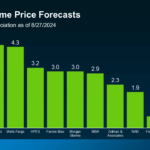Why Comparing Mortgage Offers Saves You Thousands
When it comes to one of life’s biggest financial commitments, a little homework goes a remarkably long way. Learning how to compare mortgages isn’t just smart—it’s potentially worth tens of thousands of dollars to your future self.
Think about this: according to the Consumer Financial Protection Bureau, identical home loans can vary by about $100 in monthly payments between different lenders. That might not sound earth-shattering until you multiply it across a 30-year mortgage—suddenly, you’re looking at $36,000! That’s a college education, a dream vacation, or a significant boost to your retirement savings… all from simply shopping around.
The most expensive mistake many homebuyers make is accepting the very first loan offer they receive. Research from LendingTree shows that getting quotes from three to five different lenders typically yields the best deals. Even a seemingly tiny interest rate difference—just 0.1%—can translate into thousands of dollars saved over your loan’s lifetime.
Thankfully, comparing mortgage offers has become much more straightforward than in years past. Today’s mortgage regulations require all lenders to provide standardized Loan Estimate forms within three business days after you apply. These uniform documents make it easy to place offers side by side for true apples-to-apples comparisons.
The heart of effective mortgage comparison involves examining several key factors: the APR (not just the interest rate), which reveals the true cost including fees; the revealing “In 5 years” section on page 3 of each Loan Estimate; your total closing costs (typically ranging from 2-6% of your loan amount); and of course, the monthly payment and loan term options (usually 15, 20, or 30 years).
Once you’ve gathered multiple offers, don’t be shy about negotiating with lenders using competing offers as leverage. Many buyers are surprised to find how flexible lenders can be when they know you’re actively shopping around.
And here’s some reassurance for the credit-conscious: mortgage shopping won’t hurt your credit score if done within a short timeframe (typically 14-45 days). Credit bureaus are smart enough to recognize this pattern as responsible shopping, not credit desperation, and count multiple mortgage inquiries as a single inquiry when they occur close together.
The few hours you invest in comparing mortgage offers might just be the most profitable time you’ll ever spend. Don’t leave money on the table—your future self will thank you.

Mortgage Basics: Why Comparison Matters
Before diving into the details of how to compare mortgages, let’s establish some fundamentals. Think of this as your foundation for making smart decisions when you’re looking at different loan offers.
When you’re comparing mortgage offers, you’ll need to understand the difference between interest rate and Annual Percentage Rate (APR). Your interest rate is simply the basic cost of borrowing money, shown as a percentage. But the APR tells a more complete story – it includes both the interest rate and certain loan costs, giving you the “true cost” picture of what you’ll be paying.
The star player in your mortgage comparison journey will be the Loan Estimate form. This isn’t just any paperwork – it’s a standardized three-page document that lenders must provide within three business days after you apply. It breaks down all the important details of your potential loan in a format that makes side-by-side comparisons much easier.
When budgeting for your new home, closing costs typically run between 2% and 6% of your loan amount. These include lender fees, third-party services like appraisals and title insurance, prepaid expenses, and more. The difference in these costs between lenders can add up to thousands of dollars!
What Is a Mortgage?
A mortgage is simply a loan specifically for buying real estate. When you take out a mortgage, you’re borrowing money to buy a home, and that home serves as collateral for the loan (meaning the lender could take it if you don’t pay).
Your mortgage payment typically has four main ingredients (sometimes called PITI):
– Principal: The amount you borrowed
– Interest: The cost of borrowing the money
– Taxes: Property taxes
– Insurance: Homeowners insurance and possibly private mortgage insurance (PMI)
Over time, your mortgage goes through a process called amortization. Early in your loan, most of your payment goes toward interest. But as you continue making payments, more and more goes toward the principal, gradually building your equity – that’s the portion of the home you actually own.
You’ll encounter different types of mortgages in your shopping journey. Conventional loans are traditional mortgages not backed by government agencies. FHA loans are insured by the Federal Housing Administration and typically have lower down payment requirements. VA loans are designed for veterans and service members, often with no down payment needed. USDA loans are available for rural and some suburban properties, also with zero down payment options.
Each loan type brings its own set of requirements, benefits, and potential drawbacks that you’ll want to consider when comparing your options.
The High Cost of Not Shopping Around
The financial impact of skipping the comparison process is truly eye-opening. As mentioned earlier, the Consumer Financial Protection Bureau found that borrowers could save around $100 per month simply by choosing a less expensive lender. Over a 30-year mortgage, that adds up to $36,000 – enough to fund a college education or build a substantial retirement nest egg.

Even small rate differences matter tremendously in the long run. A rate saving of just 0.1 percentage point on a $300,000 mortgage can save you thousands. For example, on a 30-year fixed-rate mortgage at 6.5%, you’d pay $1,896 monthly. Drop that rate to 6.4%, and your payment becomes $1,875 – saving you $21 every month or $7,560 over the life of your loan.
According to the latest research on borrower savings, the spread between high and low interest rates offered to similar borrowers can be as much as 0.75 percentage points. On a $250,000 loan, that difference could mean paying an extra $115 per month – or over $41,000 more over the life of your loan.
As mortgage expert Bob Walters notes, “The biggest mistake first-time homebuyers make is not shopping around for their mortgage. They often go with the first lender they talk to and potentially leave thousands of dollars on the table.”
Preparing to Shop for a Loan
Getting ready to shop for a mortgage is a bit like training for a marathon – the preparation you do beforehand makes all the difference in your success. Before you start collecting those Loan Estimates, let’s make sure you’re truly ready to put your best financial foot forward.
Your credit score is your mortgage shopping passport. For conventional loans, most lenders want to see at least 620, while FHA loans might work with scores as low as 580 (or even 500 if you can put down more money upfront). Though – the higher your score, the sweeter your interest rate will be. Even a 20-point improvement could mean thousands saved over the life of your loan.
Then there’s your debt-to-income ratio (DTI) – a number lenders care about almost as much as your credit score. This percentage shows how much of your monthly income goes toward paying debts. Most lenders prefer seeing housing costs take up between 15% and 28% of your income, with all debts (including your potential mortgage) staying under 36-43%. When your DTI climbs above 35%, your budget starts feeling the squeeze, and most lenders draw a hard line somewhere between 41% and 50%, depending on the loan program.
Timing matters too! The mortgage shopping sweet spot is about 30-90 days before you plan to buy. This window gives you breathing room to gather documents, possibly boost your credit score, and thoughtfully compare offers without making rushed decisions you might regret later.
Gather Your Financial Paperwork
Lenders love paperwork – and having yours ready will make the process so much smoother. Think of this as gathering ammunition for your mortgage battle:
- Recent pay stubs (typically covering the last 30 days)
- W-2 forms from the past two years
- Federal tax returns (including all schedules) from the past two years
- Bank statements from the last couple of months
- Statements from retirement and investment accounts
- A valid photo ID
- Documentation for any substantial deposits or gifts
- Rental history if you’re a first-time buyer
- Divorce decree, if applicable (especially important for alimony or child support)
If you’re self-employed or have irregular income streams, prepare to dig deeper. You’ll likely need profit and loss statements or business tax returns to show lenders your financial stability isn’t just a happy accident.
Boost Your Credit & Set a Realistic Budget
Before you apply for pre-approval, give your credit profile some TLC:
First, check your credit reports from all three major bureaus at annualcreditreport.com. You’d be surprised how common errors are – and how much they might be hurting your score. Found something fishy? Dispute it right away.
Next, work on lowering your credit utilization by paying down those card balances. Aim to use less than 30% of your available credit – your score will thank you. And while you’re in mortgage-shopping mode, put the brakes on opening new credit accounts. Those hard inquiries and new accounts can temporarily ding your score when you need it most.
Above all, pay every bill on time. Your payment history weighs more heavily than anything else in your credit score calculation.
Now, about that budget… Just because a lender says you qualify for a certain amount doesn’t mean that’s what you should borrow. Think about:
Your down payment goal (conventional loans typically want at least 5%, though 20% helps you avoid the extra cost of PMI)
Your comfort level with monthly payments (what feels manageable, not just what’s technically possible)
Any future life changes that might impact your income (planning to switch careers or start a family?)
Those extra homeownership costs beyond the mortgage (maintenance, utilities, HOA fees, and the inevitable “oops, the water heater died” emergencies)
Use an affordability calculator to find your personal sweet spot based on your income, existing debts, and planned down payment. Keeping your housing costs between 15% and 28% of your income gives you financial breathing room that you’ll appreciate when life throws its inevitable curveballs.
The best mortgage isn’t just about the lowest rate – it’s about finding terms that fit comfortably with your overall financial picture for years to come. For more detailed guidance on mortgage fundamentals, check out our beginner’s guide to home loans.
How to Compare Mortgages Step-by-Step
Now that you’re prepared, let’s dive into the actual process of how to compare mortgages effectively. This systematic approach will help you identify the best overall value, not just the lowest advertised rate.

When I was comparing mortgages for my first home, I felt overwhelmed by all the numbers and terms. What made the biggest difference was having standardized forms from each lender with identical loan parameters. This ensured I wasn’t trying to compare apples to oranges.
Before we jump into the steps, let’s quickly look at fixed-rate versus adjustable-rate mortgages. Each has its place depending on your situation:
| Feature | Fixed-Rate Mortgage | Adjustable-Rate Mortgage |
|---|---|---|
| Initial Rate | Typically higher | Usually lower |
| Rate Changes | Never changes | Changes after initial fixed period |
| Payment Predictability | Completely predictable | May increase over time |
| Best For | Long-term homeowners | Short-term homeowners (3-7 years) |
| Risk Level | Lower risk | Higher risk |
Step 1: Request Multiple Loan Estimates — the core of how to compare mortgages
The Loan Estimate is your mortgage shopping best friend. Think of it as a standardized nutrition label for home loans that makes comparison shopping much easier.
Start by applying with 3-5 different lenders within a short timeframe (ideally 14-45 days). This timing is important because credit bureaus will count these as a single inquiry, protecting your credit score. Make sure you’re asking for the exact same loan from each lender – same loan amount, down payment, loan type, and points scenario.
Within three business days of your application, each lender must provide you with an official Loan Estimate (not just a worksheet or scenario). This three-page document follows a standardized format that makes comparison straightforward.
When you get these documents, put them side by side and focus on these key sections:
Page 1 shows your loan terms, projected payments, and costs at closing. Look at the interest rate, monthly principal and interest payment, and whether the rate can increase after closing. Also check for any prepayment penalties or balloon payments lurking in the fine print.
Page 2 breaks down all your closing costs. Pay special attention to Section A (origination charges) as these are direct lender fees that often vary significantly between companies. Sections B through H cover services you can and cannot shop for, plus any lender credits that might offset your costs.
Page 3 contains what I consider the most valuable section – the “Comparisons” area. The “In 5 years” line is particularly useful as it shows your total payments and principal paid off during that period.

As mortgage advisor Sarah Johnson explains, “The ‘In 5 years’ figure is one of the most valuable metrics on the Loan Estimate. It gives you a clear picture of the true five-year cost of each loan, making it easier to compare offers even when they have different rate and fee structures.”
Step 2: Analyze Rates, APR & Points — deep dive into how to compare mortgages
With your Loan Estimates in hand, it’s time to look beyond the flashy advertised rates and understand the true cost of each offer.
First, understand the difference between interest rate and APR. The interest rate is what you’ll pay on the loan balance itself. The APR includes both the interest rate and certain fees, giving you a more comprehensive picture of the loan’s cost. A significantly higher APR compared to the interest rate is a red flag that indicates high fees.
Next, consider discount points. These are essentially prepaid interest – you pay more upfront to secure a lower rate over the life of the loan. One point costs 1% of your loan amount (like $3,000 on a $300,000 loan) and typically reduces your rate by about 0.25%.
To determine if points make sense for you, calculate the breakeven period. If paying $3,000 in points saves you $50 monthly, you’ll need 60 months (5 years) to recoup that cost. If you plan to move or refinance before then, points probably aren’t worth it. If you’ll keep the loan longer, they might be a smart investment.
Don’t forget to ask each lender about their rate lock policies. A rate lock guarantees your interest rate won’t change for a specific period (typically 30-60 days), protecting you from rate increases during the loan process. Find out if there’s a fee for the lock, what happens if rates fall after you lock, and whether the lock can be extended if closing gets delayed.
Step 3: Calculate Monthly & Lifetime Costs
Looking at the big picture means understanding both your monthly payment and the total cost over the life of the loan.
Your total monthly payment includes more than just principal and interest. It also covers property taxes, homeowners insurance, possibly mortgage insurance, and HOA fees if applicable. Make sure each lender is including the same components in their payment estimates.
Add up all closing costs due at signing, including lender fees, third-party fees like appraisal and title insurance, prepaid expenses, and initial escrow deposits. These typically range from 2-6% of your loan amount and can vary significantly between lenders.
For a true lifetime cost comparison, use mortgage calculators to determine the total interest paid over the life of each loan, your total payments (principal + interest), and your equity buildup at different points like 5, 10, and 15 years.
Financial advisor Michael Chen puts it perfectly: “Looking at just the interest rate can be misleading. A slightly higher rate with lower fees might actually cost less if you sell or refinance within a few years. That’s why calculating the total cost over your expected ownership period is crucial.”
Most homeowners either sell or refinance within 5-10 years, which is why that “In 5 years” figure on the Loan Estimate is so relevant. Don’t pay thousands extra for a slightly lower rate if you won’t keep the loan long enough to benefit from the savings.
For more detailed information about shopping for the right mortgage, check out our comprehensive guide at More info about Shopping.
Evaluating Lenders & Negotiating the Best Deal
Finding the best mortgage isn’t just about numbers. The lender’s reputation, service quality, and flexibility are equally important parts of the equation when learning how to compare mortgages.

Let’s face it – not all lenders are created equal. Each type brings something different to the table:
Banks might offer you relationship discounts if you’re already a customer with checking or savings accounts. They typically have stricter requirements but often service their own loans, meaning you’ll send your monthly payments directly to them rather than to a company you’ve never heard of.
Credit unions often shine with lower rates and fees thanks to their non-profit status. As a member-owner, you might find they’re more willing to work with your unique situation. Their personalized service can be a breath of fresh air, though you’ll need to meet their membership requirements first.
Mortgage brokers are like personal shoppers for your home loan. They have access to multiple lenders and can often find solutions for tricky situations like self-employment or unique properties. While they can save you considerable legwork, make sure you understand how they’re compensated – whether by you, the lender, or a combination of both.
Online lenders have disrupted the mortgage world with competitive rates (thanks to lower overhead costs) and streamlined digital processes. Many can close loans faster than traditional lenders, but the quality of customer service varies dramatically from one to another.
Comparing Lender Types & Reputation
Beyond the dollars and cents, consider these human factors when choosing your mortgage partner:
How quickly does the lender respond when you have questions? In the world of home buying, waiting days for answers can be excruciating. A good lender will get back to you promptly and explain complex terms without making you feel silly for asking.
The lender’s closing track record matters tremendously. Nothing is more stressful than a delayed closing that leaves you and your moving truck in limbo. Check reviews from past customers – did the lender consistently close on time? How did they handle unexpected hiccups?
Digital convenience can make or break your mortgage experience. Can you upload documents from your phone at midnight when you finally have time? Will you be able to track your loan’s progress online, or will you be left wondering what’s happening?
Local expertise shouldn’t be overlooked either. A lender familiar with your market might know about special programs for your area, have relationships with local appraisers who understand neighborhood values, and can recommend trustworthy local insurance agents or contractors.
Don’t be shy about checking online reviews, asking friends for referrals, or interviewing potential lenders. This relationship will last years – possibly decades – so it’s worth finding someone you trust and enjoy working with.
Negotiation Tactics That Work
Once you’ve gathered multiple Loan Estimates, you’re no longer just a hopeful borrower – you’re a customer with options. Here’s how to make the most of your position:
Leverage those competing offers like a pro. Don’t just vaguely mention you “got a better deal elsewhere.” Show lenders the actual Loan Estimates from their competitors and be specific: “XYZ Lender is offering me the same loan with $1,200 less in origination fees. Can you match that?”
Fee reductions are often more negotiable than you might think. Origination fees, application fees, processing fees, and underwriting fees all have wiggle room, especially if you have strong credit and competing offers.
If you’re tight on cash for closing, asking for lender credits might be your secret weapon. Instead of negotiating a lower rate, request credits to offset your closing costs. The lender makes their money back through the slightly higher rate, and you bring less cash to closing – a win-win if you’re stretching your savings.
When life happens and your closing gets delayed, don’t automatically accept rate-lock extension fees. Politely but firmly request the lender to extend your rate lock at no additional cost, especially if the delay wasn’t your fault.
Don’t forget to investigate relationship discounts. Many lenders offer reduced rates if you set up automatic payments from your checking account or if you maintain a certain balance in linked accounts.
As mortgage broker James Wilson wisely notes, “Don’t be afraid to negotiate. Many borrowers simply accept the first offer they receive, but lenders expect negotiation and often build room into their initial offers.”
Avoiding Common Pitfalls & Hidden Fees
Even the most careful mortgage shoppers can fall prey to these common traps if they don’t know what to watch for:
Those tempting “no-closing-cost” mortgages aren’t actually free – they’re simply shifting the costs. Either the closing costs are being rolled into your loan balance (meaning you’ll pay interest on them for years) or the rate is higher to offset those costs. Run the numbers over your expected time in the home to see if this approach makes sense for your situation.
Prepayment penalties can severely limit your options down the road. These fees, charged if you pay off your mortgage early through sale, refinance, or extra payments, might make a loan look attractive now but cause headaches later. Always ask if your loan includes these penalties.
Watch out for loans with balloon payments that require a large lump-sum payment at the end of the term. While the initial monthly payments might look attractively low, that balloon payment can create serious financial stress when it comes due.
The industry term “overages” refers to the extra profit lenders sometimes build into your rate or fees – essentially charging you more than their minimum required price. Comparing multiple offers helps you spot and avoid these hidden profits.
Be suspicious of vague junk fees with creative names like “administration fee” or “processing fee.” Question these charges directly: “What exactly does this fee cover that isn’t already covered by the origination fee?” Many lenders will reduce or remove these fees if challenged.
Consumer advocate Lisa Martinez warns, “One common tactic is to advertise an extremely low rate but then load the loan with points and fees. Always look at the APR and total closing costs to get the full picture.”
The mortgage shopping process may seem overwhelming, but the potential savings make it well worth your effort. For more detailed guidance on navigating the mortgage marketplace, check out our comprehensive guide to shopping for mortgages. And if you’re a first-time buyer, our first-time homebuyers toolkit walks you through every step of the journey.
The right lender isn’t just about the lowest rate – it’s about finding a trusted partner for one of life’s biggest financial decisions.
Conclusion
Successfully comparing mortgage offers requires preparation, attention to detail, and a willingness to negotiate. By following the steps outlined in this guide, you’ll be well-equipped to find the mortgage that best fits your financial situation and homeownership goals.

Remember these key takeaways about how to compare mortgages:
The mortgage journey might seem daunting at first, but armed with knowledge, you’ve now got everything you need to make a confident, informed decision. Take a moment to appreciate what you’ve learned—you’re now better prepared than most homebuyers who simply accept the first offer that comes their way.
The preparation work you’ve done—checking your credit, organizing your documents, and understanding your budget—has laid a solid foundation. Requesting those Loan Estimates from multiple lenders using identical loan parameters wasn’t just paperwork; it was your ticket to potentially saving tens of thousands of dollars.
When you compared not just interest rates but also APRs, closing costs, and that revealing five-year cost figure, you were seeing the complete financial picture that many borrowers miss. And by evaluating lenders based on both their numbers and their service quality, you’re ensuring a smoother journey to homeownership.
Negotiation isn’t being difficult—it’s being smart. Those competing offers aren’t just papers; they’re powerful leverage tools that can put money back in your pocket for years to come. And by staying vigilant about hidden fees and those misleading “no-cost” options, you’ve protected yourself from common pitfalls.
The time you invest in comparing mortgage offers will pay dividends throughout the life of your loan. Even small savings in your rate or fees can add up to tens of thousands of dollars over time—money that stays in your pocket rather than going to your lender.
At Your Guide to Real Estate, we’re committed to helping you steer every aspect of the homebuying process. Our experts stay up-to-date on market trends, lending practices, and regulatory changes to provide you with the most current and useful information.

Whether you’re a first-time homebuyer or a seasoned real estate investor, taking the time to thoroughly compare mortgage offers is one of the most financially savvy decisions you can make. Your future self will thank you for the thousands of dollars you’ve saved through careful comparison and negotiation.
For more information about mortgages and the homebuying process, check out our Beginner’s Guide to Home Loans and our First-Time Homebuyers Toolkit.




















